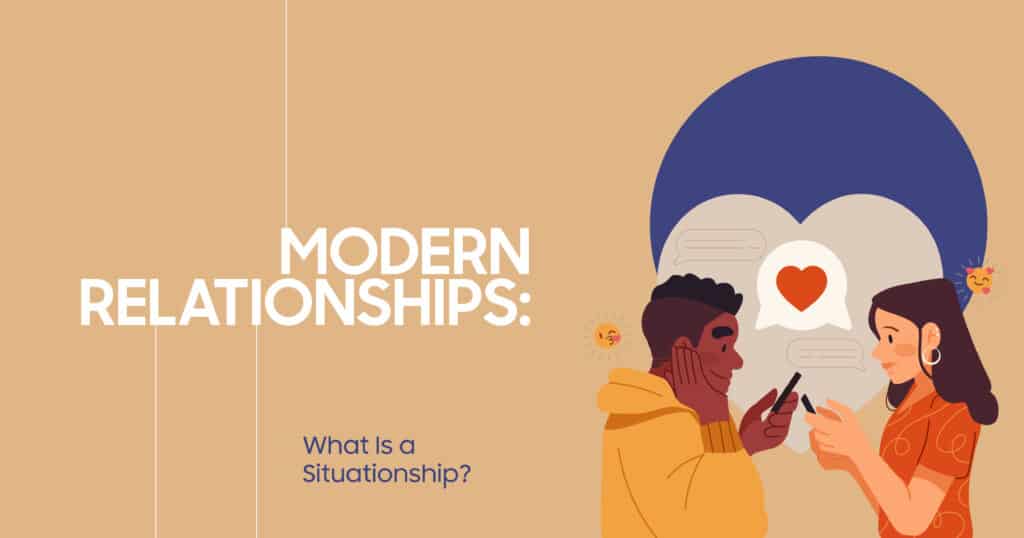Love and dating today are far from what they used to be. With texting, swiping, and countless online options, many people find themselves in something that feels like a relationship, yet isn’t. If you’ve ever asked, “Are we a couple or just hanging out?” you might be in a situationship.
Situationship results in a romantic or sexual scenario that has no specific labels, commitment, or expectations. It is not as casual as a fling, but doesn’t qualify as a full-blown relationship either. Recent surveys have revealed that more than 60 percent of young adults have entered into a situationship at least once, which means it has gained popularity as a normal dating pattern.
We are going to go through what a situationship means, how it compares to a regular relationship, what communication, emotional connection, and boundary mean, and how to navigate these undefined dynamics in this blog with clarity.
Defining a Situationship
A situationship is a non-formal romantic or sexual relationship that has no labels. It neither entirely falls on a friendship nor on a traditional relationship, and more often than not, they are characterized by affection, physicality, and togetherness, but no one talks about where they are headed.
Situationships are not as committed as a real relationship and, therefore, each participant may not be on the same level in relation to expectations or opportunities. It is more individual than a fling, but less organizational than a partnership.
The most typical cases of the situationships occur when:
- Individuals prefer being together without committing to an obligation
- Neither spouse is sure of what they wish in the future
- A fear of opening up or a historical wound preventing emotional intimacy isn’t realized
Signs of a Situationship
Not all love relationships are clear-cut. Do you feel like you are uncertain and do not know what is going on in terms of the relationship? You may be having a situation ship. It can be figured out via the following typical symptoms:
- You haven’t clearly defined the relationship or labeled it
- Communication is inconsistent, sometimes intense, sometimes non-existent
- There are no discussions about the future or long-term plans
- Physical intimacy is present, but the emotional connection feels surface-level
- One or both people avoid commitment or serious conversations
- You feel uncertain, anxious, or frequently question where you stand
- The dynamic feels like a relationship at times, but other times it’s distant
- There are no clear boundaries, and expectations are unspoken
- You’re hesitant to bring up your feelings or ask for clarity
- The relationship exists in the moment, but lacks direction or growth

Situationship Vs Traditional Relationships
With all the dating modernity, it is quite confusing the line between a situationship and a proper relationship, particularly when there is an aspect of emotional attachments and physical intimacy. Nevertheless, the two forms of links have several differences, especially in the aspect of commitment, boundaries, communication, and long-term intimacy.
The knowledge of the differences will allow you to make more conscious decisions regarding the state of your emotional health and relationship objectives. Following is a side-by-side comparison:
| Feature | Situationship | Traditional Relationship |
| Commitment | Undefined or minimal | Clearly defined and mutually agreed upon |
| Communication | Inconsistent or unclear | Open, honest, and regular |
| Emotional Connection | Varies, often superficial | Deep and intentionally nurtured |
| Boundaries | Often blurred or unspoken | Clearly discussed and respected |
| Future Planning | Rarely discussed | Commonly includes long-term goals |
| Labels | Usually avoided or delayed | Defined as boyfriend/girlfriend/partner, etc. |
| Exclusivity | Often ambiguous or open-ended | Typically agreed upon and expected |
| Conflict Resolution | Avoided or left unaddressed | Handled through mutual effort and care |
| Sense of Security | Uncertain or unstable | Stronger emotional stability and clarity |
Emotional Impact of Situationships
Although a situationship may provide relative freedom and flexibility, it may equally be a source of emotional confusion, especially when one participant falls in love and the other one wants it to be casual only. Without clear communication or commitment, it’s easy to remain stuck in emotional limbo.
The inconsistency and indistinctness of a situationship can cause confusion and a lack of satisfaction, as well as internal conflict. One tends to either start doubting their self-value or start over thinking interactions in a quest to seek validation. This ambiguity might evoke anxiety, feelings of loneliness, and heartache in case one of them nurtures higher expectations.
Among typical emotional reactions to situations are:
- Feeling emotionally drained from constantly guessing where you stand
- Developing strong feelings without knowing if they’re reciprocated
- Suppressing needs or expectations to avoid pushing the other person away
- Experiencing jealousy or insecurity due to a lack of exclusivity
- Struggling to walk away, even when it no longer feels fulfilling
- Feeling used or undervalued when emotional or physical intimacy lacks clarity
- Emotional burnout from ongoing confusion or one-sided effort
Establishing Healthy Boundaries
The fact that a situationship lacks any defined structure can cause the relaxation of emotional boundaries, and this is another reason to create personal boundaries. Boundaries safeguard your mental and emotional well-being by defining what you can and cannot do comfortably and what you expect of all this especially when boundaries are undefined.
Healthy boundaries may be created to help:
- Prevent emotional burnout
- Maintain self-respect
- Encourage mutual understanding
- Clarify needs around intimacy, time, and commitment
Effective Communication
Any boundary-setting process is based on open and honest communication. In a situationship, this means clearly expressing your needs—even if you’re unsure where the other person stands. Here are a few practical tips to help guide that conversation:
- Be direct but kind – Say what you need clearly, without blaming or attacking
- Use “I” statements. For example, “I feel overwhelmed when things are unclear,” instead of “You never define us.”
- Check in regularly – Feelings can change; make space to revisit the dynamic
- Listen actively. Be willing to hear the other person’s needs, too
- Don’t fear the outcome. Honest talks may feel scary, but they lead to clarity and growth
Therapy for Relationship Clarity
Therapy can be a powerful tool for gaining clarity, especially when you’re confused about your role in a situationship or feel emotionally overwhelmed, feeling emotionally overwhelmed, or unsure about your purpose within the relationship in a situationship. The conversation with a licensed mental health professional offers an objective ground to discuss your feelings, discern patterns, and clarify what it is that you really require out of your relationships.
Therapy assists a person to:
- Understand emotional attachment styles
- Build confidence in setting boundaries
- Gain insight into what drives their relationship choices
- Improve communication skills and emotional awareness
Build Healthy Relationships With Treat Mental Health Texas
We know that dating nowadays is difficult. Situationships may not be oppressive, yet it may cause confusion or emotional draining. Our caring staff at Treat Mental Health Texas can assist in the understanding of your relationships by providing guidance, emotional support, and customized therapy to help you know just what relationships are!
Contact us today to discuss your next step towards more fulfilling and healthy relationships.

FAQs
What is the difference between a situational relationship and a committed relationship?
A situationship is a casual relationship that lacks any definition and has no commitment or future plans. A committed relationship involves mutual exclusivity, emotional intimacy, and shared goals for the future.
How can you establish healthy boundaries in a casual and undefined situation?
Begin by expressing yourself clearly with regard to emotional needs, comfort levels and expectation. Healthy boundaries are achieved through open communication, upholding personal space as well as conducting check-ins regularly.
What emotional challenges arise from being in a situationship?
Their common challenges are confusions, anxieties, fear of rejection, and emotional fatigue. Sitting in situationships, people can face the problem of insecurity based on the ambiguity of intentions or emotional reciprocity.
How can effective communication improve a situationship’s dynamics?
Transparency and openness may help to decrease misunderstanding, foster consistency in expectations, and safety of emotions. It assists in enabling people to express their emotions, which can enhance or reinvent the relationship.
When should someone seek therapy to navigate a situationship?
Situationship can lead to stress, low self-esteem, and emotional well-being impediment, and, in such a case, a visit to the therapist is recommended. A specialist may lead you through the emotions and help you make beneficial decisions.










